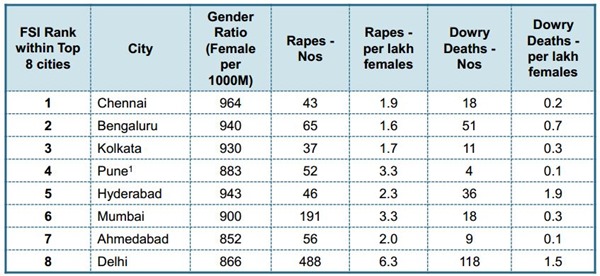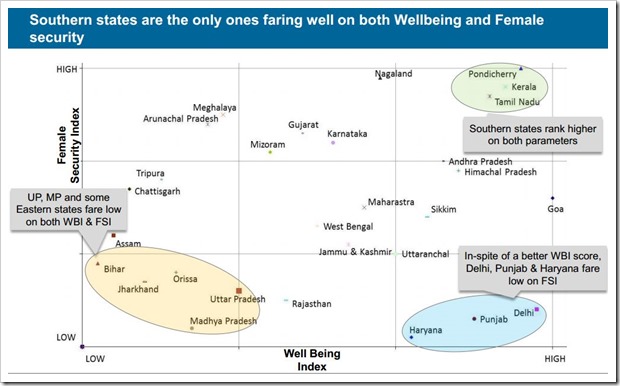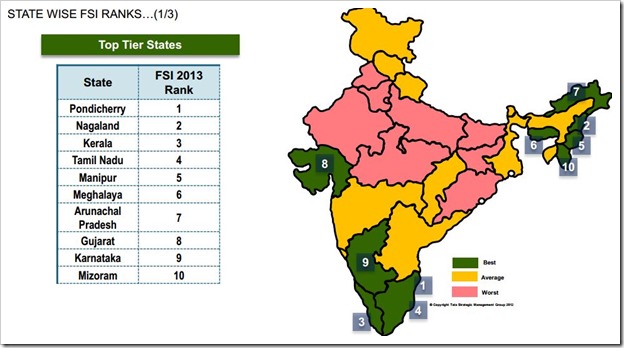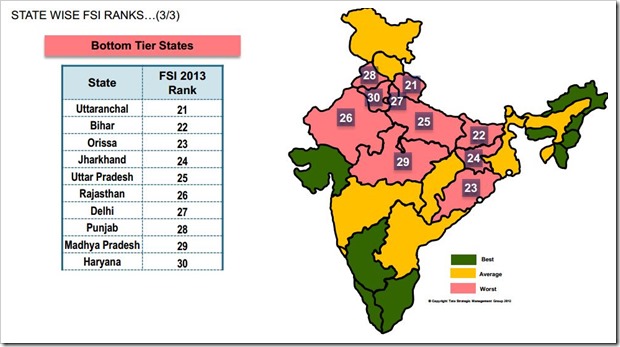Chennai emerged as the most well to do urban area while Delhi NCR was the least secure for women. Punjab, Haryana, Delhi, Himachal Pradesh and Kerala, Tamil Nadu, Andhra Pradesh were two state clusters that were ranked at the top in Tata Strategic Management Group’s 2013 edition of Well Being Index (WBI). Gujarat, southern states and most north-eastern states were ranked as secure for women in TSMG’s Female Security Index (FSI).
Goa, Delhi, Pondicherry, Kerala and Tamil Nadu were the top 5 states according to the Well Being Index. Others among the top tier were Punjab, Himachal Pradesh and Andhra Pradesh. Bihar, Assam, Chhattisgarh, Jharkhand and Tripura had the lowest ranks. Uttar Pradesh, Meghalaya, Arunachal Pradesh, Madhya Pradesh and Orissa were also featured in the WBI’s bottom tier states.
A total of 10 states were ranked as bottom tier states by TSMG’s Well Being Index. This was an indication that these 10 states had been rated below average across various benchmarks including home amenities, kitchen amenities, education, hygiene, entertainment, communication, transport and healthcare.
A larger implication of Tata Strategic Management Group’s Well Being Index surfaces when the population of the bottom tier states is considered. Effectively the study’s index placed approximately 515 crore Indians or nearly 43% of the entire population of the country in its bottom tier or below average category when it came to basic amenities and needs. It placed only 270 crore or about 22% of the country’s population in its top tier category, according to 2011 census.
Pondicherry, Nagaland, Kerala, Tamil Nadu and Manipur were the top 5 states in Tata Strategic Management Group’s Female Security Index which measured a region’s three key benchmarks – Gender ratio in the 0-6 years age group, incidences of rape and dowry deaths. Meghalaya, Arunachal Pradesh, Gujarat, Karnataka and Mizoram were also ranked by the index in its top tier category.
Haryana, Madhya Pradesh, Punjab, Rajasthan and Delhi were the worst ranked states in the FSI. Rajasthan, Uttar Pradesh, Jharkhand, Orissa, Bihar and Uttaranchal were also classified as bottom tier states when it came to security of women.
The study drilled down to a micro level to identify rankings for its Female Security Index for India’s largest urban cities and clusters. Chennai, Bengaluru, Kolkata and Ahmedabad were ranked most secure while Delhi, Hyderabad and Pune were ranked least safest.
According to TSMG’s FSI, Delhi had a poor gender ratio with 866 females per 1000 males. The study estimated that the Delhi NCR region witnessed 581 rapes, more than 13 times the number of rapes witnessed in Chennai. Delhi NCR also witnessed 193 dowry deaths, more than 21 times the number of dowry deaths in Ahmedabad.

Tata Strategic Management Group’s Well Being Index highlighted that there was no relation between its Well Being Index and Female Security Index. “The low ranks on Female security Index even in districts that are highly ranked in well- being index clearly point to the need for cultural and social introspection” said K. Raman of TSMG.
This was evident as clusters like Delhi, Punjab and Haryana featured high on the Well Being Index but were placed in the bottom rung in the Female Security Index. Uttar Pradesh, Madhya Pradesh, Orissa, Bihar and Jharkhand were ranked lower than average in both indices. While southern states like Kerala and Tamil Nadu got a higher than average ranking in both indices.




@akkiman – Interesting and well laid out observation. I am really not sure which numbers are wrong… but what I think is rounding off the numbers to one after decimal may also have played a role, but that does not take away from the fact that their is discrepancy somewhere… Let me give it a bit more thought and get back to you..
I find the data used for the survey perplexing. For example, the number of dowry deaths in both Chennai and Mumbai was 18 yet ratio was 0.3 for chennai and 0.2 for Mumbai. This means that female population of chennai is 1.5 times that of Mumbai which we know is incorrect as per the last census in 2011 if you consider the city (http://www.census2011.co.in/city.php) or the the Urban agglomeration (http://www.census2011.co.in/urbanagglomeration.php)
If Chennai has a 0.2 per lakh dowry death ratio and it had 18 dowry deaths, it means that it has a female population of 90 lakhs which is wrong as per census data and mumbai has a female population of 60 lakhs. Similarly using same calculations, bangalore has 72 lakh , delhi has 78 lakhs, Hyderabad has 18.94 lakhs, Pune has 36 lakhs. All of this data is incorrect as per the census.
Similarly if you consider the rapes per lakh ratio,
Chennai now has suddenly 22 lakh females, Mumbai 57 lakhs, bangalore has 40 lakhs , delhi has 78 lakhs, hyderabad has 20 lakhs , Pune has 15 lakhs.
Granted that this was 2011, and they did a survey in 2013 but that means that their sample size was inaccurate and therefore I feel these results could be mis-leading.